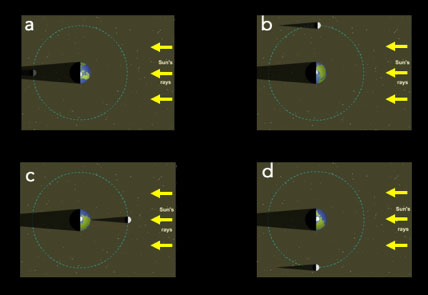The lunar phases repeat “moonthly,” but sometimes the Moon gets involved in more dramatic events: eclipses. There are two basic types of eclipse (Figure 2.27).
- A lunar eclipse occurs when Earth comes directly between the Sun and Moon, so that Earth’s shadow falls on the Moon.
- A solar eclipse occurs when the Moon comes directly between the Sun and Earth, so that the Moon’s shadow falls on Earth.
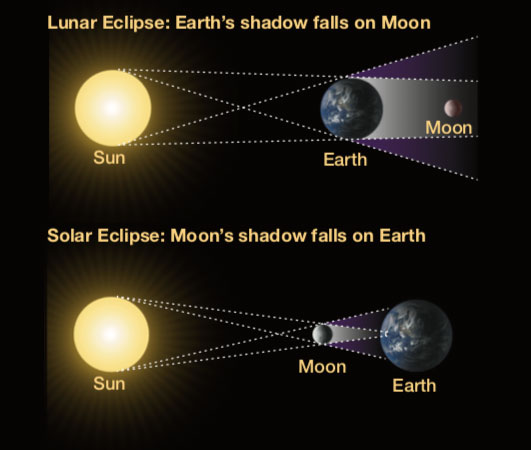
Activity
Modeling Eclipses
Place your “Sun” (ideally, a lamp with a bright light bulb) on a table. Each student should stand a few steps away holding a ball at arm’s length to represent the Moon. The student’s head represents Earth, and the ball represents the Moon.
Step 1: Hold your Moon ball at arm’s length, and move it in a circle around you to represent the Moon’s orbit around Earth (your head). Based on what you’ve already learned about Moon phases, identify the positions in the that correspond to the major phases: new, waxing crescent, first-quarter, waxing gibbous, full, waning gibbous, third-quarter, waning crescent.
You should have found the phase positions as shown in this diagram:
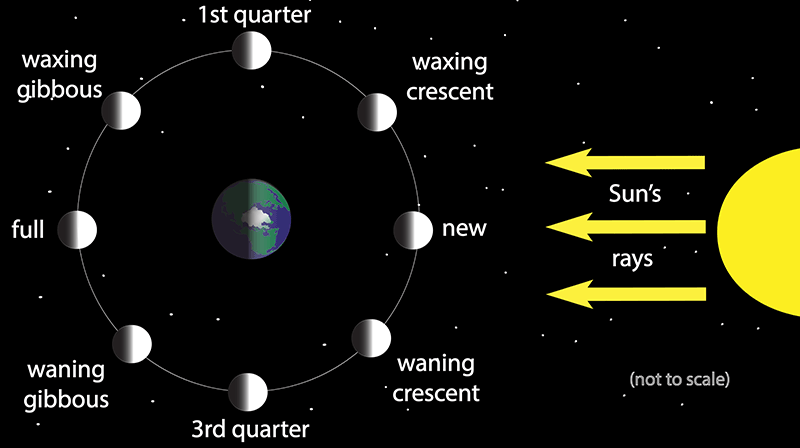
Step 2: A lunar eclipse occurs when Earth’s shadow falls on the Moon. Move your Moon around your head until you find the position at which it is possible for a lunar eclipse to occur. What phase is this? Note: You probably won’t be able to see the shadow that your head (Earth) is casting in the classroom, but you should be able to visualize where this shadow must be.
You should notice that a lunar eclipse can happen only at full moon, since that is the only time that Earth can lie directly between the Sun and Moon. If you picture the shadows that Earth and the Moon cast into space, then the geometry for a lunar eclipse looks like the following diagram. Be sure you understand what the diagram shows.
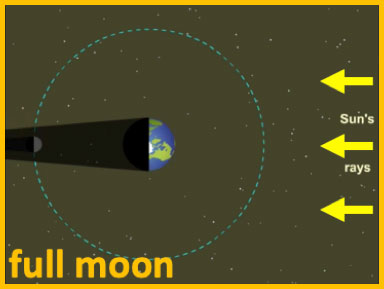
Step 3: A solar eclipse occurs when the Moon’s shadow falls on Earth, which means that the Moon can block out the Sun as viewed from Earth. Move your Moon around your head until you find the position at which it is possible for a solar eclipse to occur. What phase is this?
A solar eclipse can happen only at new moon, as shown in the following diagram. Be sure you understand what the diagram shows.
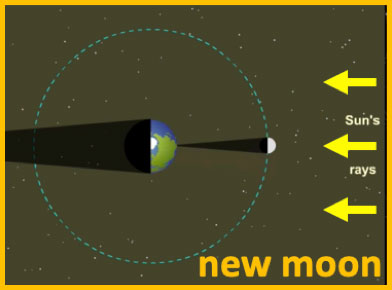
Teacher Notes: This activity works best if you represent the Sun with a bright light bulb on a lamp (with no lamp shade) placed on the center of a table and students use Styrofoam balls on a stick to represent the Moon. If you don’t have the lamps, you can instead use a ball (choose one that is larger than the Moon balls) to represent the Sun, and just tell students to imagine where the shadow would be cast. If you don’t have the Styrofoam balls, almost any small ball will work as the “Moon.”
- Note that for this activity, we will ignore the fact that the Moon’s orbit is inclined to Earth’s – we’ll introduce this detail a bit later. So for now, we are focusing only on the phases at which eclipses are possible.
- You may wish to point out that this activity is nowhere close to being to scale. Remind students to look back to Section 1.1.2, where they found that with a 3-inch (7.6 cm) diameter ball for Earth, the Moon would be an approximately 1-inch ball located about 7 1/2 feet (2.3 meters) away from Earth, while the Sun would be about 8 meters in diameter and located about 900 meters away.
Partial and Total Eclipses
Eclipses can be spectacular sights, especially when they are what we call “total” eclipses. But not all eclipses are total, as you can see easily with this next activity.
Activity
Modeling Partial and Total Eclipses
Continue the prior activity, but instead of a lamp, use a ball on the table to represent the Sun. Note: You will probably need to hold your Moon ball much closer than arm’s length in order to see your eclipses.
Step 1: Put your ball at the new moon position, so that a solar eclipse is possible. (Be sure you hold it in a way that keeps it directly in line with the ball representing the Sun.) Now hold the Moon ball still, cover one eye, and move your head until the Moon ball completely blocks your view of the Sun ball. What kind of eclipse does this represent?
This represents a total solar eclipse. It is a solar eclipse because the Moon is blocking your view of the Sun, and it is total because the Sun is completely blocked from view.
Step 2: Now move your head slightly in any direction until the Moon ball is only partly blocking the Sun ball. What kind of eclipse does this represent?
This represents a partial solar eclipse. Again, it is a solar eclipse because the Moon is blocking your view of the Sun, but it is now partial instead of total because only part of the Sun is blocked from view.
Step 3: Now find all the other ways in which you can move your head (such as left, right, up, down) and still see a partial eclipse. How does the size of the region in which you can see a partial eclipse compare to that in which you can see a total eclipse?
Your answer should correspond to what is shown below in Figure 2.28, in which there is a moderate-size circular region in which you can see a partial eclipse, but only a small central region in which you can see a total eclipse.
Teacher Notes: This activity builds on the prior one so that students can see the difference between partial and total eclipses. However, as noted at the beginning of the activity, in this case it is best to replace the light bulb with a ball, because otherwise the students would have to looking directly into the bright light, which would make this activity more difficult.
- The idea behind this activity is that the student’s head (Earth) is in the position of the screen in Figure 2.28. By moving their heads, students see that there’s a fairly wide circle in which they can see a partial eclipse, but only a small central circle in which they see a total eclipse.
- Important: Be sure that you’ve selected balls that make it possible for the students to hold the Moon ball sin a way that will completely block their view of the Sun ball. As noted in the activity, this may require holding it closer to their eye.
- This works best when students hold the Moon ball still, moving only their head to see the difference between partial and total eclipse. Some students may have difficulty with this coordination, in which case you could have another student hold the Moon ball still while the first student moves their head (Earth) to see the eclipse.
- As noted for the prior activity, this is nowhere close to being to scale. You can have interesting discussions about how difficult it would be to line everything up if you tried to do it correctly to scale.
We can turn what you’ve seen in the activity into the more precise geometrical model shown in Figure 2.28. We imagine a giant screen behind a world (such as the Moon or Earth) in space, then trace paths from the edges of the Sun past the edges of the world and onto the screen. Because the Sun and world are both round (spherical), the screen ends up with two distinct shadow regions:
- a central full shadow, also called the umbra, in which sunlight is fully blocked
- a surrounding partial shadow, also called the penumbra, in which light from only part of the Sun is blocked.
In other words, if you placed your eye within the full shadow, you would see the Sun totally eclipsed, and if you placed your eye within the partial shadow, you would see a partial eclipse. Let’s now see how this shadow geometry applies first to lunar eclipses (when Earth is the world casting the shadows) and then to solar eclipses (when the Moon is the world casting the shadow).
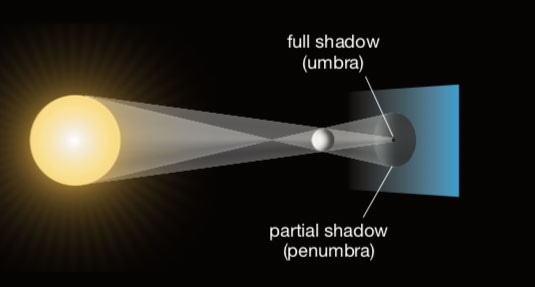
Three Types of Lunar Eclipse
Teacher Notes: We start with lunar eclipses because they correspond fairly directly to the geometry in Figure 2.28, with Earth as the object casting the shadow and the Moon moving across the screen (as a small part of its orbit around Earth). Note that to see the correspondence clearly, you need to think of the Moon as being smaller than the small circle of Earth’s full shadow on the screen.
When Earth is between the Sun and Moon, the shadow geometry leads to three types of lunar eclipse, all shown in Figure 2.29. Going from the bottom to the top in that figure:
- If the Moon passes only through Earth’s partial shadow, or penumbra, we see what we call a penumbral lunar eclipse. Penumbral eclipses are the most common type of lunar eclipse (because the partial shadow is much larger than the full shadow), but they are difficult to notice because the full moon darkens only slightly compared to a normal full moon.
- If the Moon also passes partly through Earth’s full shadow, we will clearly see the outline of the dark full shadow on the Moon. Because this means that the dark full shadow is only partly covering the Moon, we call this a partial lunar eclipse. Note that the curvature of the shadow we see during a partial lunar eclipse provides direct proof that our world is round (spherical). Indeed, the curvature of the shadow was first cited as proof of a round Earth almost 2,500 years ago (by the ancient Greeks).
- If the Moon passes entirely through Earth’s full shadow, we see a total lunar eclipse. The only sunlight that reaches the Moon at this time is the light that is bent toward the Moon by Earth’s atmosphere, giving the Moon a reddish glow.
I was wondering...
Why Does the Moon Turn Red During a Total Lunar Eclipse?
The best way to understand the eerie red color of the Moon during a total lunar eclipse is to imagine what you would see if you were standing on the Moon at this time (on the side facing Earth). During the total lunar eclipse, you would see Earth’s night side completely blocking your view of the Sun. However, this also means that along the edges of Earth’s round shape, you’d be looking at places where it was either sunrise or sunset. You would therefore see Earth’s round shape surrounded by the reddish glow of all those sunrises and sunsets, which means that this reddish light must be illuminating the Moon at this time.
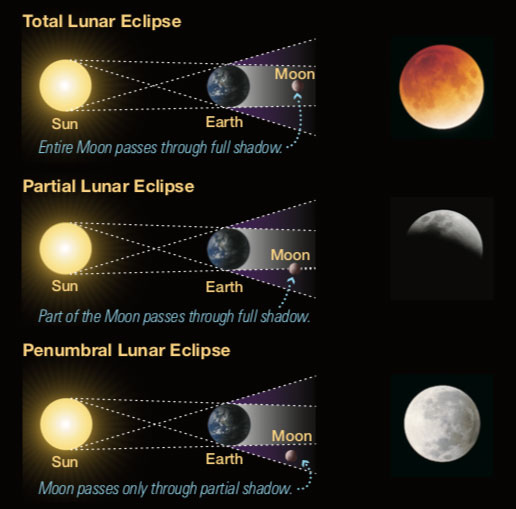
Remember that the Moon is orbiting around Earth, and it moves all the way through Earth’s shadows in just a few hours. Therefore, a total lunar eclipse always begins and ends with periods in which the eclipse is penumbral (but you probably won’t notice these), and also has partial phases as the Moon gradually makes its way into and out of the full shadow (Figure 2.30).
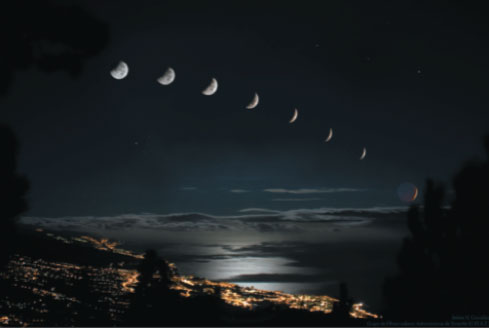
That’s really all there is to lunar eclipses, but if you want to check how deep your understanding goes, try the following questions, discussing with classmates if you wish. Then click to see the answers.
Teacher Notes: Except for the first question, which is fairly straightforward, the other questions are fairly challenging. But if you use models as in the activities above, they ought to be doable.
1. Where on Earth would you have to be located to see a lunar eclipse?
You must be facing the Moon to see a lunar eclipse, and since lunar eclipses occur only at full moon, this means you can see a lunar eclipse from any place on Earth’s night side.
2. Suppose you were standing on the Moon when people on Earth were seeing a total lunar eclipse. What would you see?
Looking at Figure 2.29 or using a model, you’ll notice that the Moon is entirely in Earth’s full shadow during a total lunar eclipse. Therefore, if you were on the Moon at this time, you would see Earth completely blocking out the Sun, which means you’d be seeing a total solar eclipse.
3. Suppose you were standing on the Moon when people on Earth were seeing a penumbral lunar eclipse. What would you see?
Looking at Figure 2.29 or using a model, you’ll notice that the Moon is in Earth’s partial shadow during a penumbral lunar eclipse. Therefore, if you were on the Moon at this time, you would see a partial solar eclipse, in which Earth would be partially blocking out the Sun.
4. Suppose you were standing on the Moon when people on Earth were seeing a partial lunar eclipse. What would you see?
It depends on where you are on the Moon. If you are in the region that is inside Earth’s full shadow, you would see the Sun completely blocked from view (a total solar eclipse). If you are in the region outside the full shadow (which is still within the partial shadow), you would see the Sun partially blocked from view (a partial lunar eclipse).
Three Types of Solar Eclipse
There are also three types of solar eclipse (Figure 2.31), but for a little different reason than for the three types of lunar eclipse. The key to understanding them is to notice that because the Moon is so much smaller than Earth, its full shadow can at best cover only a small area of Earth’s surface (up to about 270 kilometers in diameter). The partial shadow covers a much larger region (typically about 7,000 kilometers in diameter), but still is not large enough to cover our entire planet. Let’s go top to bottom through Figure 2.31:
- If you are located within the small region covered by the Moon’s full shadow, you will see a see a total solar eclipse. Day will turn into night as the bright Sun is completely blocked from view. However, this will last no more than few minutes, because the combination of Earth’s rotation and the Moon’s orbital motion causes the Moon’s shadow to race (typically at almost 2,000 kilometers per hour) across the face of Earth, quickly moving it from one place to the next.
- If you are located within the larger region covered by the Moon’s partial shadow you will see a partial solar eclipse, in which only part of the Sun is blocked from view.
- Because the Moon’s orbital distance from Earth varies, the Moon’s angular size also varies. If a “total” eclipse occurs at a time when the Moon is relatively far from Earth, the full shadow may not reach Earth at all, which means that even right behind the full shadow the Moon will appear too small to fully block the Sun. Instead, if you are located in this region directly behind the full shadow, you’ll see the Moon in front of the Sun, but with a ring of sunlight still visible around it. Because the Latin word for a ring is annulus, we call this an annular eclipse.
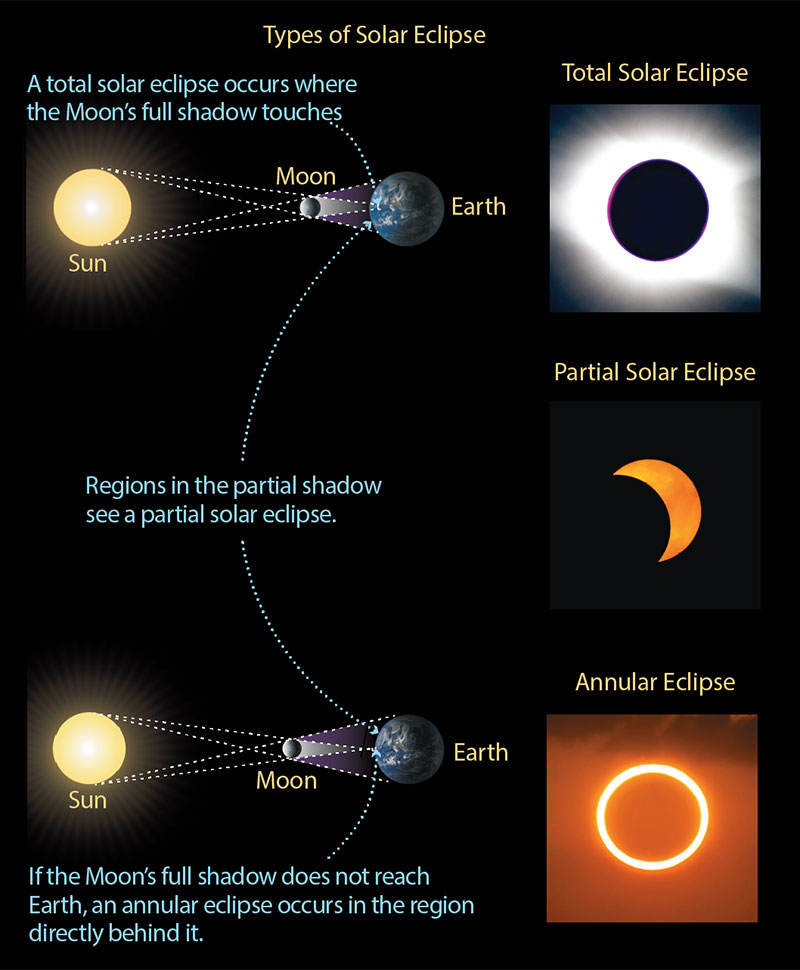
Activity
Modeling an Annular Eclipse
Continue the prior activity. Again, a ball on a table represents the Sun, a ball in your hand represents the Moon, and your head represents Earth.
Step 1: With one eye covered, hold your Moon ball in a position where it completely blocks your view of the Sun ball, so that you are representing a total solar eclipse, just as you did earlier.
Step 2: Now move your Moon ball gradually farther away from your eye, until it no longer looks big enough to completely cover the Sun. If you hold it just right, you should be able to see your ball blocking all but a ring-shaped region of the Sun ball — which means you are representing an annular eclipse.
Teacher Notes: This simple activity just asks students to hold their Moon ball so it blocks all but a ring (annulus) of the Sun ball, representing an annular eclipse. The only challenge is that they need to be standing at a distance from the Sun ball where a bent arm allows their Moon ball to completely block the Sun ball, while a straighter arm leads to the annular view.
The following video summarizes the different types of eclipses and how they occur.
Video
Understanding Eclipses Part 1: Types of Eclipse.
Wow Factor
See Totality!
Quiz
Note: As always, after you finish the quiz, be sure you read the feedback that explains the correct answers, to make sure you understand the reasons for these answers.
How Often Do Eclipses Occur?
By now you know that eclipses can occur at new moon (for solar eclipses) and full moon (for lunar eclipses). But most new and full moons don’t have eclipses. The reason is that the Moon’s orbit is slightly inclined (by about 5°) to the plane of Earth’s orbit around the Sun (the ecliptic plane). Try this activity to see why the inclination of the Moon’s orbit means we don’t always have eclipses at new and full moon.
Activity
Modeling The Moon’s Orbital Inclination
This activity requires a hula hoop (or similar rigid hoop).
We will now build on the prior activity, but this time tape your Moon ball onto a hula hoop. Hold the hula hoop so that your head (Earth) is in the middle and you can turn the hula hoop to show the Moon ball’s orbit around your head. (It might be easier to have someone else hold the hula hoop for you.)
Step 1: Hold the hula hoop so it is perfectly horizontal to the ground, and sit or bend your knees until it is also level with the Sun ball on the table. The hula hoop now represents what the Moon’s orbit would look like if it did not have any inclination to Earth’s orbit. With this orientation, when would you see eclipses?
In this orientation, you would have a lunar eclipse at every full moon and a solar eclipse at every new moon. In other words, there would be eclipses every month.
Step 2: Now tilt the hula hoop so it is at an angle to the ground (with your head still in the middle), with the hula hoop higher than the Sun ball in front of you and lower than the Sun ball behind you. Is there still an eclipse at every new and full moon? Why or why not?
Now, the Moon ball is slightly above the Sun ball at the new moon position, and slightly below it at the full moon position, which means you won’t see any eclipses.
Step 3: Keep the hula hoop tilted, but move it around so that the high and low points change position. Can you find a position in which you can see eclipses at new and full moon even though the hula hoop is still tilted? How?
As you face toward the Sun ball, if the hula hoop has its high point to your left and its low point to your right, or vice versa, then the Moon ball will be directly in line with the Sun and Earth (your head) at the new and full moon positions.
Teacher notes: This activity is designed to represent the Moon’s orbit with a hula hoop. The fact that the student’s head represents Earth, and the student can walk around the table to represent Earth’s orbit, means that Earth’s orbit is horizontal (parallel to the floor). Therefore, holding the hula hoop flat represents zero orbital inclination for the Moon.
- The Moon’s actual orbital inclination is about 5°, but not only is it difficult to hold the hula hoop with that small of a tilt, but this activity actually works better if that tilt is exaggerated somewhat (up to about 30°).
- If you are unfamiliar with eclipse geometry yourself, you will find it helpful to notice how this activity corresponds to Figure 2.32 below, thinking of the hula hoop as the Moon’s orbit.
We can turn our activity into a more precise model by imagining the ecliptic plane as the surface of a pond. If you think of the Moon’s orbit like the hula hoop in the activity, then it is inclined so that half the hula hoop is above the pond surface and half is below it. This means that the orbit crosses through the pond surface in two places, which we call the nodes of the Moon’s orbit. Figure 2.32 shows Earth and the Moon’s orbit in four different places along Earth’s orbit around the Sun.
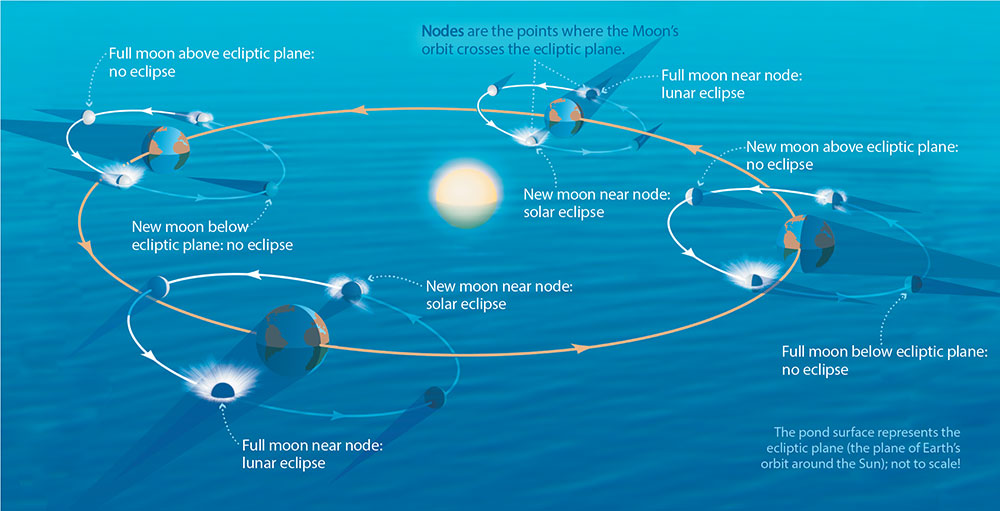
To see how the Moon’s orbital inclination affects eclipse timing, try the following questions, discussing with classmates if you wish. Then click to see the answers.
1. Using our pond model, consider the orientation of the Moon’s orbit at the upper left (in the red rectangle). Are eclipses possible at this time?
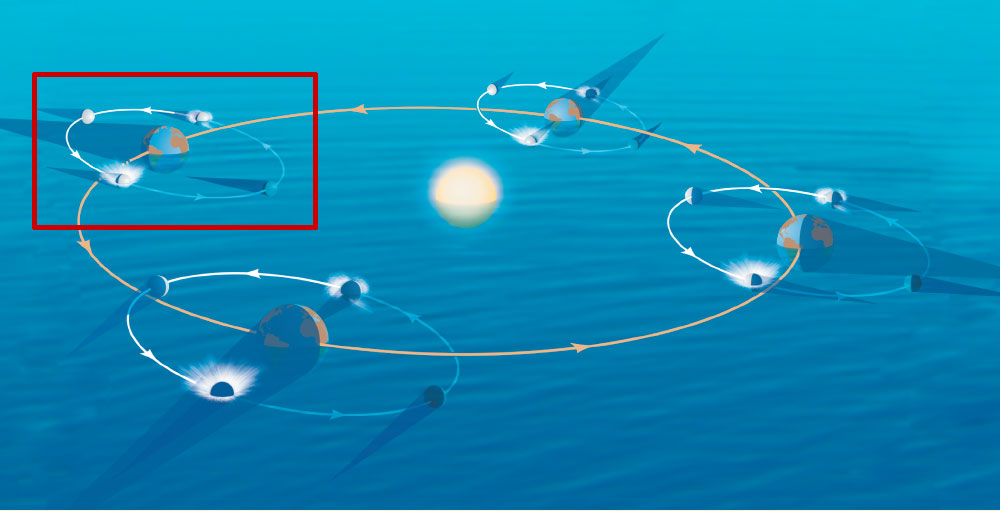
No. Eclipses are not possible at this time, because the full moon position is above Earth’s shadow and the new moon’s shadow falls below Earth.
2. Of the four orbital orientations shown for the pond model in Figure 2.32, which ones allow for eclipses?
Only the orientations at the lower left and upper right, because those are the only places where the full and new moons are right on the pond surface, where the Moon’s shadow can touch Earth at new moon and Earth’s shadow can touch the Moon at full moon.
3. About how many times each year is it possible to have eclipses?
Two: Because eclipses are possible in the two orientations you identified above (lower left and upper right), there are two time periods each year in which eclipses are possible. In fact, as discussed in the Wow Factor box, there is always a lunar eclipse and a solar eclipse during each of these time periods (which are called eclipse seasons).
Activity
When Eclipses Can Occur
Continue the prior activity with the hula hoop, starting with it tilted so that the high point is in front of you (toward the Sun ball) and the low point behind you.
Step 1: Keep the hula hoops orientation steady, but now walk around the table to represent Earth’s orbit around the Sun. Find the two places where eclipses are possible, as shown in our Moon pond model.
Teacher Notes: This is a one-step activity, designed to make sure students see the correspondence between the hula hoop model and the Moon pond model, and understand why there are about two periods (eclipse seasons) each year in which eclipses are possible.
To summarize, eclipses can occur only when two conditions are met:
- the phase of the Moon must be full (for a lunar eclipse) or new (for a solar eclipse), and
- the new or full moon must occur when the Moon is very close to a node.
Because these conditions occur about twice each year, there are generally two lunar and two solar eclipses each year. In fact, if Figure 2.32 showed the entire story, the two time periods in which eclipses can occur would always come exactly 6 months apart. However, the actual separation between these periods is a little less than 6 months, for reasons explained in the Wow Factor box and in the summary video below.
Teacher Notes: The video should be a useful summary, but note that the portions dealing with eclipse seasons and the saros cycle go well beyond 8th grade NGSS expectations.
Video
Understanding Eclipses Part 2: When and Why Eclipses Occur.
Journal Entry
Your Next Eclipse
Go to the web page timeanddate/eclipse. Near the top of the screen you will see the words “Find Solar and Lunar Eclipses in Your City.” Type your city name into the box to find upcoming eclipses that will be visible at your location. In your journal, make an entry titled “Eclipses I should Watch For” and below that put in a list of upcoming eclipses that you’ll be able to see, with details about their type and exactly when you should be outside to watch them. For solar eclipses, be sure you also plan to get eclipse glasses or have some other safe viewing plan.
Wow Factor
Predicting Eclipses
I was wondering...
How Does the Moon Move on the Celestial Sphere?
Earlier in this chapter you learned that the Sun appears to move steadily eastward around the celestial sphere, completing one circuit each year along the path we call the ecliptic. The Moon also appears to move steadily eastward relative to the stars — taking about a little less than a month to go all the way around the celestial sphere — but what is its precise path? The answer is that because the Moon’s orbit around Earth is inclined by about 5° to Earth’s orbit around the Sun, the Moon appears to follow a path around the celestial sphere that is tilted by about 5° to the ecliptic. The reason we don’t show this path on the celestial sphere is because it gradually changes with time, for the same reason that eclipses don’t recur at the same times each year (see the Wow Factor — Predicting Eclipses).
